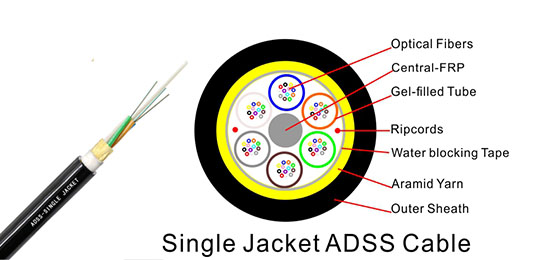Understanding the Applications and Uses of ADSS Cables in Overhead Transmission Lines

Understanding ADSS Cables
ADSS cables, also known as all-dielectric self-supporting cables, play a vital role in modern overhead transmission lines. These fiber optic cables are specifically designed for use in overhead installations and offer a range of benefits. Understanding the applications and installation process of ADSS cables is crucial to ensure their efficient and effective use in telecommunications and utility networks. By exploring the features and advantages of ADSS cables, we can gain valuable insights into their significance in modern infrastructure development.
Benefits of ADSS Cables
Enhanced Durability
ADSS cables are engineered with a high level of durability, making them capable of withstanding even the most extreme weather conditions. This robust design ensures reliable performance in various environmental settings, including areas prone to heavy winds, ice, and snow.
The all-dielectric nature of ADSS cables contributes to their exceptional durability by rendering them resistant to corrosion and impervious to the damaging effects of lightning strikes.
Low Maintenance
One of the key advantages of ADSS cables is their minimal maintenance requirements, stemming from their sturdy construction. This characteristic not only enhances operational efficiency but also translates into significant cost savings for network operators over the long term.
With reduced maintenance needs, ADSS cables offer a practical and cost-effective solution for overhead transmission lines, ensuring consistent performance with minimal intervention.
ADSS Cable Comparison
When comparing ADSS (All-Dielectric Self-Supporting) cables to OPGW (Optical Ground Wire) cables, several key differences come to light, highlighting the unique advantages of ADSS cables in overhead transmission lines.
ADSS vs. OPGW Cables
Higher Tensile Strength: ADSS cables exhibit higher tensile strength compared to OPGW cables, making them more resilient and capable of withstanding greater mechanical stress. This characteristic ensures the reliable performance of ADSS cables in challenging environmental conditions.
Simpler and More Cost-Effective Installation: The installation process for ADSS cables is comparatively simpler and more cost-effective than that of OPGW cables. This not only reduces installation time but also contributes to overall cost savings for operators.
Advantages of ADSS Cables
Better Resistance to Electromagnetic Interference: ADSS cables provide superior resistance to electromagnetic interference when compared to OPGW cables. This feature ensures consistent signal quality and reliability, especially in areas with high levels of electromagnetic activity.
Lightweight Nature and Reduced Load on Transmission Towers: The lightweight design of ADSS cables results in a reduced load on transmission towers, enhancing overall efficiency and structural integrity. This makes them an ideal choice for minimizing the impact on existing infrastructure while ensuring optimal performance.
ADSS Cable Applications
Telecommunications
ADSS cables play a pivotal role in modern telecommunications, offering a reliable and efficient solution for long-distance communication networks. The high bandwidth capacity of transmission line cables makes them ideal for supporting the extensive data transfer requirements of telecommunication applications. Additionally, the all-dielectric self-supporting nature of ADSS cables ensures consistent signal quality, contributing to their widespread use in telecommunication infrastructure.
In telecommunications, the demand for dependable and durable overhead line cables is met by ADSS cables, which are designed to withstand environmental challenges while maintaining signal integrity over long distances. The versatility of ADSS cables allows for seamless integration into existing telecommunication networks, providing a cost-effective and sustainable solution for expanding communication infrastructure.
Utility Networks
Within utility networks, ADSS cables are extensively employed in power distribution and transmission applications. The robust construction and enhanced durability of ADSS cables make them well-suited for various utility applications, including overhead power lines and distribution networks. Their ability to withstand mechanical stress and environmental factors positions power line cables as a reliable choice for ensuring uninterrupted power supply across utility networks.
The adaptability of ADSS cables enables their seamless integration into diverse utility applications, offering a versatile solution that aligns with the evolving needs of modern infrastructure development.
ADSS Cable Installation
Installation Process
When it comes to adss cable installation for overhead lines, the process involves securing the cables to the transmission towers using specialized hardware designed for this purpose. The mounting process of ADSS cables is crucial to ensure their stability and longevity in overhead installations. These fiber optic cables are self-supporting, eliminating the need for a separate messenger wire during the installation process. This feature streamlines the installation, making it more efficient and cost-effective.
The fiber optic cable installation for overhead lines requires precision and adherence to industry standards to guarantee optimal performance. Proper tensioning and alignment of the cables are essential aspects of the installation process, ensuring that they can withstand mechanical stress and environmental factors over time.
Safety Considerations
During the ADSS cable mounting process, it is imperative to prioritize safety measures to prevent accidents and ensure the well-being of installation personnel. Qualified professionals with expertise in handling fiber optic cables should oversee the installation process to guarantee proper functioning and minimize potential risks associated with high-voltage power lines.
Adhering to safety protocols and utilizing appropriate personal protective equipment (PPE) are fundamental aspects of ensuring a secure working environment during adss cable installation. By prioritizing safety considerations, operators can mitigate potential hazards and uphold industry best practices throughout the installation process.
Insights on ADSS Cables
Advantages of ADSS Cables
Reliable Performance: ADSS cables offer a dependable and long-lasting solution for modern overhead transmission lines. Their all-dielectric self-supporting nature ensures consistent signal quality and structural integrity, making them an ideal choice for telecommunications and utility applications.
Cost-Effective Infrastructure Development: The utilization of ADSS cables contributes to cost savings and efficient infrastructure development. Their low maintenance requirements and durable design make them a sustainable option for expanding overhead transmission networks.
Sustainable Solution
ADSS cables present a sustainable solution for overhead transmission lines, aligning with the growing emphasis on environmentally friendly infrastructure. Their durability and minimal maintenance needs support the long-term sustainability of telecommunications and utility networks.
See Also
Advantages of ADSS Fiber Optic Cables for Overhead Power Lines
ADSS Fiber Cable versus Other Options for Long Span Uses
The Strength of ADSS Fiber Optic Dead End Kits in Network Cabling


